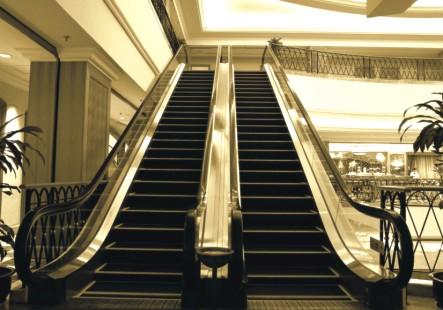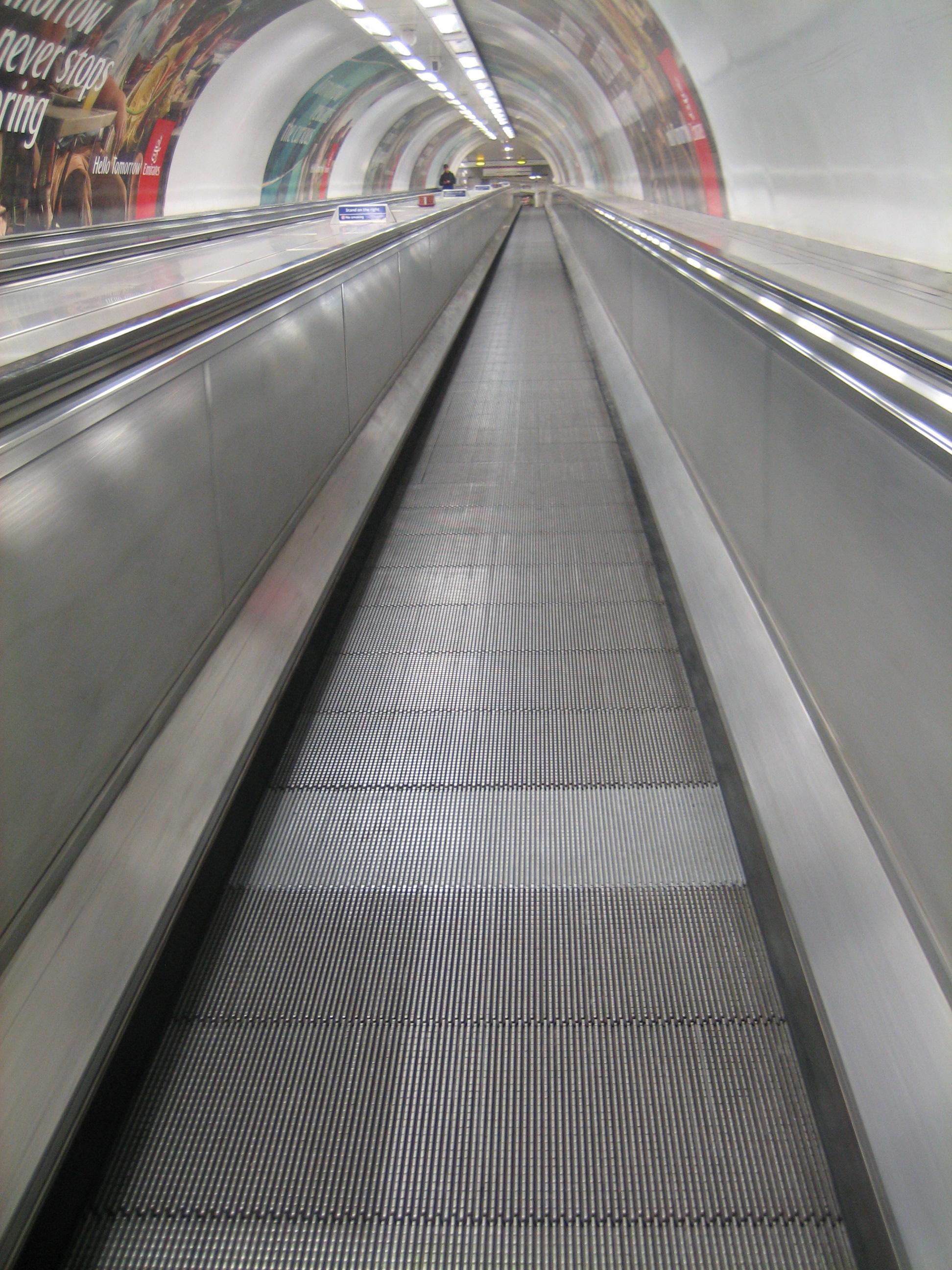

Every minute of every day, somewhere in the world, millions of people are using Escalators and Travelators. In retail stores, shopping centers, cinemas, sports complexes, exhibition halls, airports, railway stations, and a host of other buildings, escalators and travelators are quietly, efficiently, safely and unobtrusively transporting large numbers of people.
Escalators and Travelators are moving stairs / walkways used commercially to efficiently transport large masses of people, cargo, and equipment from point to point. Escalators and walkways help transport people from one level to another, or between floors of a building, theatre, arena, stadium, mall, or exhibit.
By conveying people continuously, escalators and travelators ensure a smooth flow of people through a building. They have the capacity to handle high traffic, and in multi-level retail centers they play a vital role in ensuring that all floors are visited evenly. Escalators and autowalks, along with elevators, are a total people and goods transportation solution.
Escalators
They are “moving stairs” that transport masses of people up or down between floors of a building. They are installed indoors or outdoors and the constant speed can be adjusted to accommodate increases or decreases in volume of passengers. The escalator’s metal grooved steps are linked together and driven by a motor-driven chain on tracks. In the event the mechanism breaks down, the escalator can still be used as a staircase access. Escalators have moving safety handrails. As the escalator ends, the steps each disappear into an end comb-plate. Escalators are installed in pairs to keep opposite flows of people all moving their designated up or down direction. It is generally agreed that an escalator is the most efficient means to move large numbers of people between floors.
Travelators
In the US “Travelators” are called “moving walkways” or “a moving sidewalk” or “autowalks”. It is a conveyor transport mechanism that slowly and safely moves people relatively long distances either along level ground or inclined distance. People stand, or walk, on the Travelator as its conveyor walkway rolls along. Travelators are typically installed in pairs to keep opposite flows of people all moving their designated direction. Travelators are generally provided in areas where people need to walk long distances with luggage, baggage carts or shopping carts. A Travelator is generally flat, but can be slightly inclined.
| Escalators | Travelators | Elevators |
| Continuous | Continuous | Interrupted |
| Mass transport | Mass transport | Limited number |
| Short-medium distances | Medium-long distances | Higher rises |
| In between floors | On one floor | In between floors |
| Steer people flow | Save time and effort | Improve accessibility |
Why Escalators and Travelators?
- They used to increase customer density and thus help boost sales in buildings used for commercial purposes.
- They ensure a smooth traffic flow.
- They help channel passenger flows.
- They have a high transportation capacity.
- They are open and convey people continuously.
- They ensure that all floor are frequented evenly.
Escalators or Travelators?
Travelators should be provided as a matter of principle whenever shopping or cabbage carts are to be transported.
Key Considerations
To achieve optimal customer density, the movement of customers within the building has to be facilitated. Distances in excess of 50 meters should be avoided on commercial premises and office buildings.
To determine the transportation requirements (Persons per hour), the following parameters ought to be considered.
- Type of building (offices, shopping center, airport; one-way traffic, two-way traffic; single- or multi-purpose building)
- Peak traffic times (office opening and closing hours)
- Population factor based on net usable area.
- Customer turnover rate per floor in department stores
- Level of travelling comfort required on the unit (uncrowded, convenient, and crowded)
Arrangement of Escalators and Travelators.
Single Unit
An inexpensive method of transporting passengers between two floor levels. Particularly suitable for small retail stores where available floor space is restricted.
Only really suitable for installations where passenger flow is in one direction, although on-demand starting can be utilized to allow travel in both directions(e.g. in the morning and down in the evening) An easily accessible staircase is required for passengers to return to the ground floor level. It Restricts traffic flow within the building.
Continuous Arrangement (One-way Traffic)
This arrangement is used mainly in retail stores to link three sales levels.
Interrupted Arrangement (One-Way Traffic)
It is inconvenient for the user but for the mall retail store owner it provides the advantage that due to spatial separation of the upward and downward directions, customers have to walk past specially placed merchandise displays. Readily accessible staircases are required for passengers to return to the ground floor level.
Parallel, Interrupted Arrangement (Two-Way Traffic)
This is used mainly in retail and public transportation buildings with heavy traffic volumes. It should be possible to reverse the direction of travel depending on the traffic flow.
Crisscross, Continuous Arrangement (Two-Way Traffic)
This allows customers to travel quickly to the upper flows without any waiting time. Frequently used to make an attractive feature of the escalators in the center of retail stores
Inclination Angles:
| Escalators | Travelators |
| Inclinations of 30 and 35 degrees are common.
30 degree inclination provides the highest travelling comfort and maximum safety for the user. The 35 degree inclination is the most efficient solution as it requires less space and can be implemented more cost-effectively. It is however perceived too steep if rises exceed 6m. |
Inclinations of 10, 11 and 12 degrees are the most common.
10 degrees provide the most comfortable ride. A 12 degree inclination is used whenever the space available is limited. |
Building Segments and the Transport Requirements.
Public transportation segment.
- High availability is vital.
- High speed (0.5 m/s) increases safety by allowing passengers to leave the platform quickly.
- Linked to building management systems.
- Standby speed.
- Heavy indoor, semi-outdoor and fully outdoor use.
- 20-24 hours running time per day.
Airport segment.
- High speed is usually required, especially for Travelators.
- Visual design is very important; airports are key reference sites.
- Availability is extremely important.
- Linked to building management systems.
- Mainly indoor.
- 18-20 hours running time per day.
Retail segment.
- Visual design and lighting options important.
- Very often belongs to the transport system of the building and linked to elevators.
- Lowest possible speed to retain shoppers in the building.
- Continuous operation very important to guide shoppers to other floors.
- Mainly indoor.
- 12-14 hours running time per day.
Office/hotel/medical segment.
- Visual quality outlook important as it represents the luxury level of the building.
- Finishing often done by customer. (Office/hotel).
- Very often belongs to the transport system of the building and is linked to elevators.
- Low running speed needed for passenger comfort.
- Standby speed operational mode.
- Mainly indoor and air-conditioned.
- 10-12 hours running time per day.
Leisure segment.
- Availability is extremely important.
- Amusement parks often have busy retail center type of traffic but in an outdoor environment.
- Stadiums where the duty cycle is short but with peak loads require a heavier solution, similar to
the public transportation segment. - Indoor, semi-outdoor and fully outdoor use.
- 12-14 hours running time per day.
Basic Escalator or Travelator Configurations.
A designer/consultant/contractor ought to have the following information at the initial stages of procuring an Escalator or Travelator.
- Load profile.
- Energy consumption.
- Step width, speed and inclination.
- Horizontal steps/pallets.
- Vertical rise.
- Operational modes.
- Type and height of balustrade.
